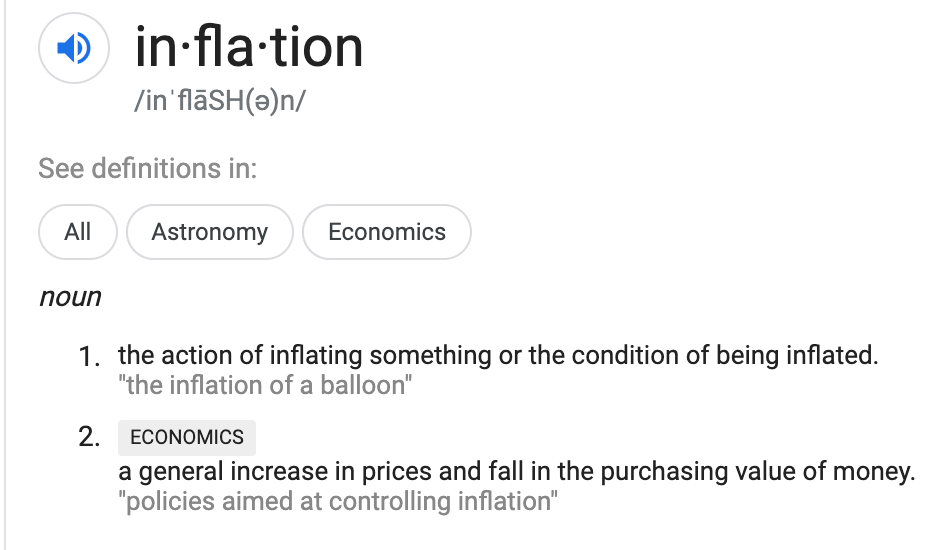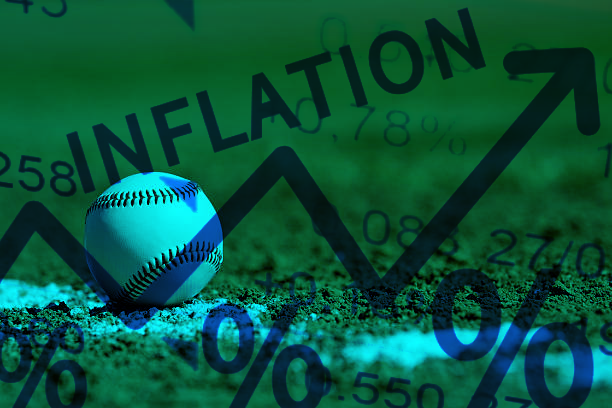INFLATION VALUES FOR KEEPER LEAGUES
⚾️ Short on time? If you need to take this article on the run with you, listen to the podcast!

Let us talk about inflation in reference to its importance in picking the best keepers from your team, targeting players from other teams and to gauge the possible player pool in your upcoming draft. By the way, is anyone guilty in #1 of the above definition? I tend to always try to inflate my players value with league posts/emails/trade offers in order to pull the best deals and value back to my team. Hey, this game is more than just a study of numbers and observation, you need to mimic savvy moves from the real world to excel in trading in your leagues. Let us discuss some important terms/slangs we will be referring to when talking about the value of players.
1. AAV (average auction value)– The first is the players’ real value. You can use several different types of values as you see fit. If you use your own projections or dollar values, use those. If you prefer to use a trusted, tried and true set of values, use those. I personally use the projected values at BaseballHQ.com combined with the recent AAV from drafts at NFBC as a baseline of values that I can expect to be in the ballpark to what others are using as a value barometer. While I do not live and die by the AAV’s, its importance lies in what to expect other owners to be bidding on these players, so you can find your pockets of value in the draft and find where the value lies in the players on your team so you can execute your hold overs accordingly. Just keep in mind the sole reason for AAV’s and ADP- it is to give us a range of expectancy of what it will cost to acquire a player- not necessarily what the player is worth. The great thing about the AAV’s from the NFC is the ability to change the date range of drafts being held to show changes in values of players due to any types of circumstances. Another benefit is that most of the input for the AAV’s is coming from players investing a lot of money to try and win these leagues. It’s a super beneficial tool for all players to have when heading into drafts. One thing to be sure of adjusting to, is your league size. You want to be consistent with the values you will use as your source but beware of the number of teams and players being drafted those projected values are being based on. If it is for a 10-team league and you play in a 12-team league, you will need to do some math to match your league.
2. Inflated value– This is the value of the player when you factor in your league specific numbers. Here are the steps to execute this.Calculate each teams’ hold over salary. Then calculate the real value of these players on each team as if it were a regular redraft auction league. Example – an owner is keeping Yoan Moncada for $10 and his projected real AAV is $20. For each team in your league, calculate these 2 separate values. This will leave you with the total amount of frozen salary and the amount of salary from the real AAV in the current market. It will look something like this:
| PLAYER | KEEEPER COSTS | AAV (4/1/20-5/26/20)** |
| JOSE RAMIREZ | $16 | $36 |
| FERNANDO TATIS | $7 | $35 |
| MOOKIE BETTS | $22 | $40 |
| SONNY GRAY | $6 | $15 |
| CHARLIE MORTON | $14 | $24 |
| TOTALS: | $65 | $150 |
**- it’s always important to use the most recent ranges of AAV’s from NFBC to adjust for any recent injuries or demotions/promotions.
Calculate the total salary of your league (ex- 12 team league x $260 budget = $3,120). If you total the amount of frozen salary from all the teams in your league and subtract it from the total league salary you end up with the amount of money left to spend via the draft. Now we must determine how much value is left to chase in the player pool. We circle back to the players being kept in your league. Now instead of adding the amount they are being held over for, you will be adding their real value (NFBC AAV). Take that total number and subtract it from the total league salary and then divide that number by the amount of real value left in the player pool. Let’s say there is $1800 left to spend in the draft and there is $1400 left of value in the player pool. $1800 divided by $1400 is 1.28, or 28%- this is the league inflation. If you are targeting a player whose real value is $20, you would tack on the inflation rate and the players inflated value is now roughly $25/26. 28% is a fairly high number, but as in most keeper leagues this is indicative of players out producing their acquisition cost from the previous year, coupled with the ability of the owner to freeze them for that value. While profit value is important when choosing to keep a player, there is a concept to understand that most players are not aware of. This is the concept of what I will call the Pull Hitter Keeper Yield. Some savvy keeper league owners might recognize this concept as a keeper player gain. Maybe you are deciding between 2 players for a keeper spot. Player A is $6 to keep and has a real value of $8 attached to him for a $2 keeper profit. Player B is $30 to keep and his real value is $32, for the same $2 profit. Here is the catch- by keeping the $30 player, you have just secured $30 worth of value UNAFFECTED by inflation. This concept helps you understand why you should not shy away from keeping higher priced players. A lot of owners have a stiff “I don’t keep guys over $25” policy and they get hurt by not understanding this important principle.
As you can see this clearly shows that the demand is far greater than the supply (more money is available than the value of the players available), so players should be bid up according to this. Where you will hold the edge is when other owners do not go through this process and will tend to abide by market value guidelines or strict AAV’S and they will stop at $23 in the auction because that is what their lists says. Being prepared by knowing that the value to acquire this player is actually more than that puts you in the driver seat to achieve draft domination. Calculate the value of all players in the draft pool by multiplying the inflation rate to the AAV to compile a new list of values to draft off of.
3. Next we have league specific value. Add/subtract any perceived value for certain players in relation to the owners in your league and their proclivity for strategies and players. This can be for:
- Yankees you know will go higher from Yankee fans being in your league
- to owners with specific drafting tendencies/strategies
- Does one owner draft all $15-20 closers? Does your league tend to value closers more than they should?
- An owner who drafts all steal threats (and maybe too many- you only need one more than the second-place team to win or one more to win in a head to head game)
- owners who put an increased focus on youngsters, or maybe the trend in your league is that prospects DON’T go for only $1 anymore
- maybe Catchers demand a lower or higher than normal draft acquisition cost
4. Positional scarcity value: make a list of how many players are being kept at each position. Determine if you think a certain player/players’ value should be lowered or raised depending on that list. For example, in a 12-team league, there are 9 second basemen being held over and you do not have one. You can reasonably bump up a player’s value to secure a good player at a position that’s naturally thin on its own this year, plus the fact that so many of them are being kept.
Other things to factor in is the players status with his MLB club. What is the contract status of the player? Is he a possible trade target and will move away from a productive setting? If you play in a league with multi-year deals, you must pay attention to those things when signing a guy long term. You want to establish if he will remain in a productive situation or ballpark. Take all of this into account when trying to project a value a player might have on draft day. Use your instincts, knowledge of your league and read the draft room to determine that value as well. More importantly, go get your guy. Tossing and turning over a dollar more can prove vain. These are all perceived values anyway and if you want to invest in a certain player- $2, $3, $5 extra on what their AAV is – go for it. Formulate your own recipe for success in your given league. As the great Ron Shandler says “the value of the player is the last dollar amount someone is willing to bid”. The value of a player varies from owner to owner. We all value differently. We can go to the same restaurant and order the same appetizer and have completely different feelings on whether we thought it was worth the price.
Just remember that inflation will remain throughout the whole draft. It doesn’t tend to normalize, especially if owners are not going above the inflated values of players and rather sticking to the AAV script. With each purchase that “sticks to the script”, inflation on the rest of the players available will rise even higher. You should try continue calculation of inflation during the draft. You can obviously do this yourself, or you can set yourself up to success by getting RotoLab. For those not familiar with it, it is the ultimate draft prep and in draft tool you can use. It comes pre-loaded with BaseballHq.com projections and even gives you the ability to edit those projections for players you feel any differently on. The inflation cost to acquire players changes on the fly with each purchase made and Rotolab does the work for you to determine the value of the remaining players. It is an amazing tool that makes drafting in any league a whole lot easier.
Owners have a natural tendency to not want to pay over a players’ real value that is listed on a web site, print publication or a value they have determined for that player from their player model and cost evaluator. Inflation stays and will even grow. Where others see you overspending, you may see yourself getting bargains at any player who goes below their inflated value. The counter point to this is that sometimes a player will return value of their actual value, and not the extra dollar amount you paid to counter the inflation. It is, however, necessary in order to go out and get the talent needed to field the best team possible.
Knowing these concepts are tremendous in helping to stay consistently good in keeper leagues by holding an edge in draft preparation. I cannot stress it enough of the importance of knowing your league and the owners you are competing against. As much as the AAV’s from NFC is helpful in determining the expected range of bids, formulating your own variance to those values- in my eyes- is even more critical. Capitalize on owner tendencies and stubbornness to adhere to the AAV and their inability to formulate their own values. This is the Pull Hitter approach to inflation value drafting. I hope this was helpful. Questions and comments are most appreciated.



